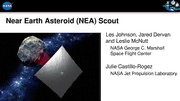
NASA Technical Reports Server (NTRS) 20170001492: Near Earth Asteroid (NEA) Scout Near Earth Asteroid (NEA) Scout Near Earth Asteroid (NEA) Scout PDF
Preview NASA Technical Reports Server (NTRS) 20170001492: Near Earth Asteroid (NEA) Scout Near Earth Asteroid (NEA) Scout Near Earth Asteroid (NEA) Scout
Near Earth Asteroid (NEA) Scout Les Johnson, Jared Dervan and Leslie McNutt NASA George C. Marshall Space Flight Center Julie Castillo-Rogez NASA Jet Propulsion Laboratory Near Earth Asteroid Scout The Near Earth Asteroid Scout Will • Image/characterize a NEA during a slow flyby • Demonstrate a low cost asteroid reconnaissance capability Key Spacecraft & Mission Parameters • 6U cubesat (20cm X 10cm X 30 cm) • ~86 m2 solar sail propulsion system • Manifested for launch on the Space Launch System (EM-1/2018) • 1 AU maximum distance from Earth Leverages: combined experiences of MSFC and JPL Close Proximity Imaging Local scale morphology, with support from GSFC, JSC, & LaRC terrain properties, landing site survey Target Reconnaissance with medium field imaging Shape, spin, and local environment NEA Scout Sponsoring Organization within NASA • Human Exploration and Operations Mission Directorate (HEOMD) Advanced Exploration Systems (AES) selected 3 cubesats for flight on the first flight of the Space Launch System • Primary selection criteria: - Relevance to Space Exploration Strategic Knowledge Gaps (SKGs) - Life cycle cost - Synergistic use of previously demonstrated technologies Payload Strategic Knowledge Gaps Mission Concept NASA Centers Addressed BioSentinel Human health/performance in high- Study radiation-induced DNA ARC/JSC radiation space environments damage of live organisms in cis- • Fundamental effects on biological systems lunar space; correlate with of ionizing radiation in space environments measurements on ISS and Earth Lunar Flashlight Lunar resource potential Locate ice deposits in the Moon’s JPL/MSFC • Quantity and distribution of water and other volatiles in permanently shadowed craters lunar cold traps Near Earth Asteroid (NEA) Human NEA mission target identification Flyby and characterize one NEA Scout • NEA size, rotation state (rate/pole position) that is candidate for a human How to work on and interact with NEA MSFC/JPL mission surface • NEA surface mechanical properties 3 NEA Scout Roles and Responsibilities Near Earth Asteroid Scout • Project Manager: Leslie McNutt (MSFC) • Science PI: Julie Castillo-Rogez (JPL) • Solar Sail PI: Les Johnson (MSFC) • Spacecraft System: JPL • Solar Sail System: MSFC NEA Scout Goals & Objectives 1) Design, develop, integrate and operate a spacecraft for the purpose of demonstrating a low cost reconnaissance capability 2) Enable asteroids as potential destinations for human exploration 3) Characterize a candidate NEA with an imager to address key SKG’s “Precursor robotics, robotic missions “Robotic exploration is the principal that investigate candidate destinations method we use to explore the solar and provide vital information to system, and is an essential precursor prepare for human explorers, will lay to human exploration of space.” the groundwork for humans to achieve SMD Strategic Goals/Objectives new milestones in deep space.” (Strategic Goal 1, Objective 1.5) HEOMD/AES Strategic Goals/Objectives (Strategic Goal 1, Objective 1.1) Baseline Target Asteroid: 1991 VG • Diameter ~ 5-12 meters • Albedo is unknown • Position is known within 2700 km (1-s) but optical observation opportunity in July ‘17 will decrease uncertainty to a few 100s km • Rotation period between a few minutes and less than 1 hour • Unlikely to have a companion • Unlikely to retain an exosphere or dust cloud – Solar radiation pressure sweeps dust on timescales of hours or day Near Earth Asteroid Scout Mission Overview Close Proximity Science High-resolution imaging, 10 /px over >30% surface SKGs: Local morphology Regolith properties JPL IntelliCam) NEA Reconnaissance <100 km distance at encounter 50 cm/px resolution over 80% surface SKGs: volume, global shape, spin properties, local environment Target Reference Target Detection and Approach: stars 50K km, Light source observation SKGs: Ephemeris determination and composition assessment Flight System Overview NEA Imager (JPL) Payload • Context Camera • “6U” CubeSat form factor Mechanical • <14 kg total launch mass & Structure Star Tracker LGA (cid:9) • Modular flight system concept (BCT) (JPL) Rad Tolerant Avionics (JPL) • ~86 m2 aluminized CP-1 solar sail (based on Propulsion NanoSail-D2) Avionics • Radiation tolerant architecture Sun Sensors • Trifold deployable solar arrays with GaAs cells (BCT) Electrical (~51.2 W EOL at 1 AU solar distance) Power • 6.2 Ah Battery System • 10 -12.3 V unregulated, 5 V/3.5 V regulated Iris 2.0 Transponder (JPL) 18650 Lithium Batteries • JPL Iris 2.0 X-Band Transponder; 4 W RF output (SDL/Panasonic) power supports doppler, ranging, and D-DOR RWA Telecom • 2 pairs of INSPIRE-heritage LGAs (RX/TX) (BCT) • 8x8 element microstrip array HGA (TX); ~1 kbps to 34m DSN at 0.8 AU • 15 mNm-s (x3) & 100 mNm-s RWAs TRAC Boom Assembly (MSFC) • Active mass translation system Attitude • VACCO R-236fa (refrigerant gas) ‘warm gas’ Solar Sail -Stowed Control (MSFC) RCS system System • Nano StarTracker, Coarse Sun Sensors & MEMS IMU for attitude determination A fully functional planetary spacecraft in a Translating Table shoebox (MSFC) 9Solar Panels & HGA RCS (TBD/AntDevCo) (VACCO) Deployed Solar Sail NEA Scout Approximate Scale Deployed Solar Sail F o l d e d , s p o m o l e e t d s y a S n n t d h a g p m i a l u F c H k d a e w g e o d t S i n U School Bus 6 h e r e Concept of Operations Overview
